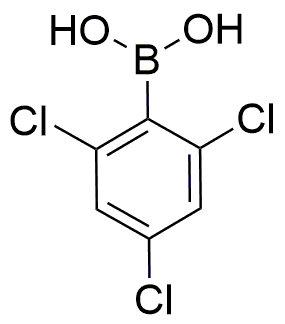2,4,6-Trichlorophenylboronic acid is widely utilized in research focused on:
- Organic Synthesis: This compound serves as a key intermediate in the synthesis of various organic molecules, particularly in the development of pharmaceuticals and agrochemicals, enhancing the efficiency of chemical reactions.
- Cross-Coupling Reactions: It is commonly used in Suzuki-Miyaura coupling reactions, which are essential for forming carbon-carbon bonds, making it invaluable in materials science and drug discovery.
- Bioconjugation: The boronic acid functionality allows for selective binding to diols, making it useful in bioconjugation techniques for labeling biomolecules, aiding in the development of targeted therapies and diagnostics.
- Environmental Applications: It can be employed in the detection and removal of pollutants, such as phenolic compounds, from wastewater, contributing to environmental sustainability efforts.
- Sensor Development: This compound is utilized in creating sensors for detecting glucose and other biomolecules, which is particularly beneficial in the medical field for diabetes management.
Informations générales
Propriétés
Sécurité et réglementation
Applications
2,4,6-Trichlorophenylboronic acid is widely utilized in research focused on:
- Organic Synthesis: This compound serves as a key intermediate in the synthesis of various organic molecules, particularly in the development of pharmaceuticals and agrochemicals, enhancing the efficiency of chemical reactions.
- Cross-Coupling Reactions: It is commonly used in Suzuki-Miyaura coupling reactions, which are essential for forming carbon-carbon bonds, making it invaluable in materials science and drug discovery.
- Bioconjugation: The boronic acid functionality allows for selective binding to diols, making it useful in bioconjugation techniques for labeling biomolecules, aiding in the development of targeted therapies and diagnostics.
- Environmental Applications: It can be employed in the detection and removal of pollutants, such as phenolic compounds, from wastewater, contributing to environmental sustainability efforts.
- Sensor Development: This compound is utilized in creating sensors for detecting glucose and other biomolecules, which is particularly beneficial in the medical field for diabetes management.
Documents
Fiches de données de sécurité (FDS)
La FDS fournit des informations de sécurité complètes sur la manipulation, le stockage et l’élimination du produit.
Spécifications du produit (PS)
Le PS fournit une description complète des propriétés du produit, notamment sa composition chimique, son état physique, sa pureté et les exigences de stockage. Il détaille également les plages de qualité acceptables et les applications prévues du produit.
Certificats d'analyse (COA)
Recherchez des certificats d'analyse (COA) en saisissant le numéro de lot du produit. Les numéros de lot et de lot se trouvent sur l'étiquette d'un produit, après les mots « Lot » ou « Lot de fabrication ».
Numéro de catalogue
Numéro de lot/série
Certificats d'origine (COO)
Ce certificat d'exploitation confirme le pays dans lequel le produit a été fabriqué, et détaille également les matériaux et composants utilisés et s'il est issu de sources naturelles, synthétiques ou autres sources spécifiques. Ce certificat peut être requis pour les douanes, le commerce et la conformité réglementaire.
Numéro de catalogue
Numéro de lot/série
Fiches de données de sécurité (FDS)
La FDS fournit des informations de sécurité complètes sur la manipulation, le stockage et l’élimination du produit.
DownloadSpécifications du produit (PS)
Le PS fournit une description complète des propriétés du produit, notamment sa composition chimique, son état physique, sa pureté et les exigences de stockage. Il détaille également les plages de qualité acceptables et les applications prévues du produit.
DownloadCertificats d'analyse (COA)
Recherchez des certificats d'analyse (COA) en saisissant le numéro de lot du produit. Les numéros de lot et de lot se trouvent sur l'étiquette d'un produit, après les mots « Lot » ou « Lot de fabrication ».
Numéro de catalogue
Numéro de lot/série
Certificats d'origine (COO)
Ce certificat d'exploitation confirme le pays dans lequel le produit a été fabriqué, et détaille également les matériaux et composants utilisés et s'il est issu de sources naturelles, synthétiques ou autres sources spécifiques. Ce certificat peut être requis pour les douanes, le commerce et la conformité réglementaire.


